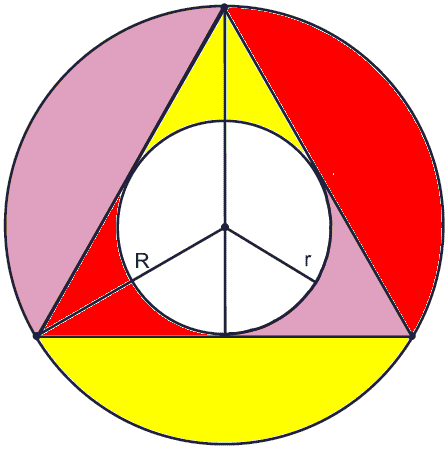Pairs of Areas in Equilateral Triangle
Prove that the sum of the shaded areas in the figure below is equal to the area of the incircle of the equilateral triangle.

References
- B. J. McCartin, An Elementary Property of the Equilateral Triangle: A Tale of Two Proofs, International Mathematical Forum, Vol. 6, 2011, no. 14, 699 - 701
|Contact| |Front page| |Contents| |Geometry| |Eye opener|
Copyright © 1996-2018 Alexander Bogomolny
Prove that the sum of the shaded areas in the figure below is equal to the area of the incircle of the equilateral triangle.

Solution
One solution is based on the following observation. There are three pairs of regions whose total area we seek to determine. The area of the circumcircle of the given equilateral triangle is thus split into three pairs of areas in question and the incircle.

Let the area in question be S, AR = πR² the area of the circumcircle, and Ar = πr² the area of the incircle.
3S + Ar = AR.
In the equilateral triangle R = 2r. This is so because, in an equilateral triangle, the same lines serve as altitudes, medians, angle and perpendicular bisectors; while the same point serves as the centroid, incenter, and circumcenter. The centroid cuts the median in ratio 2:1. The "2" part is the circumradius, the "1" part is the inradius. Therefore,
3S = 4Ar - Ar = 3Ar,
and, finally, S = Ar, as required.
|Contact| |Front page| |Contents| |Geometry| |Eye opener|
Copyright © 1996-2018 Alexander Bogomolny
73497308
